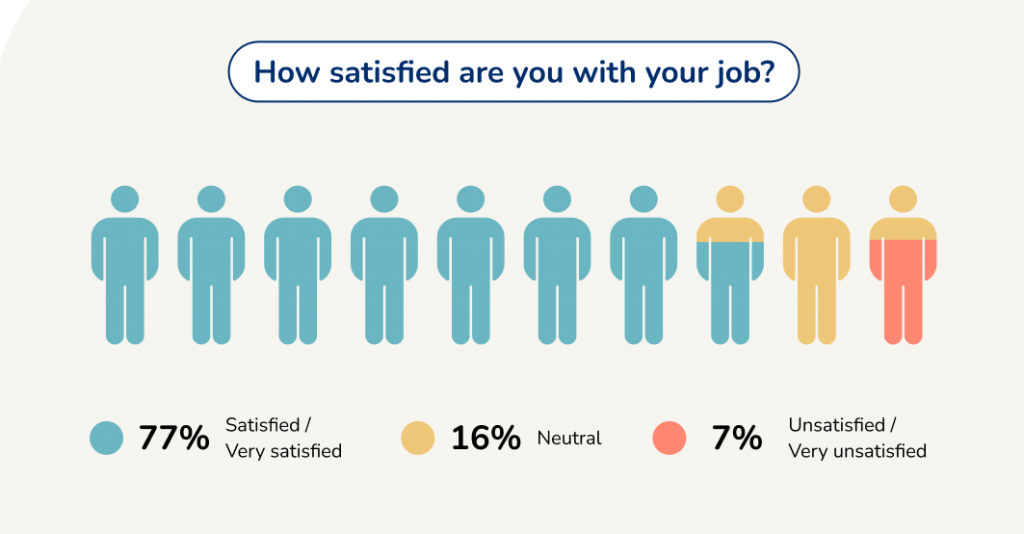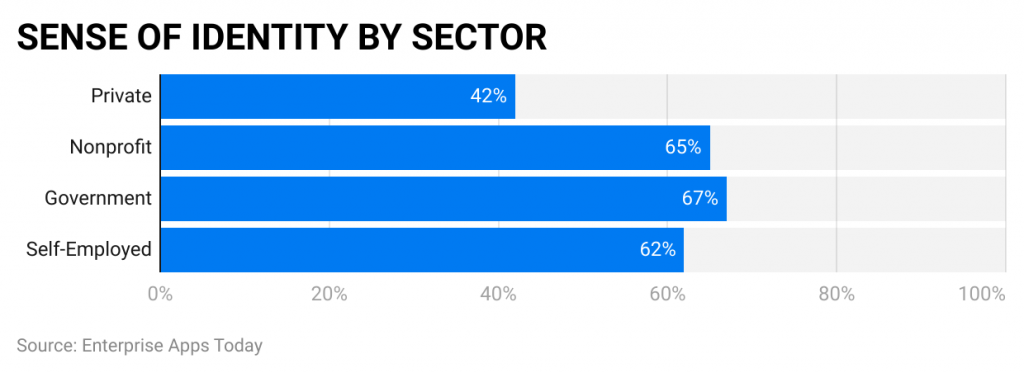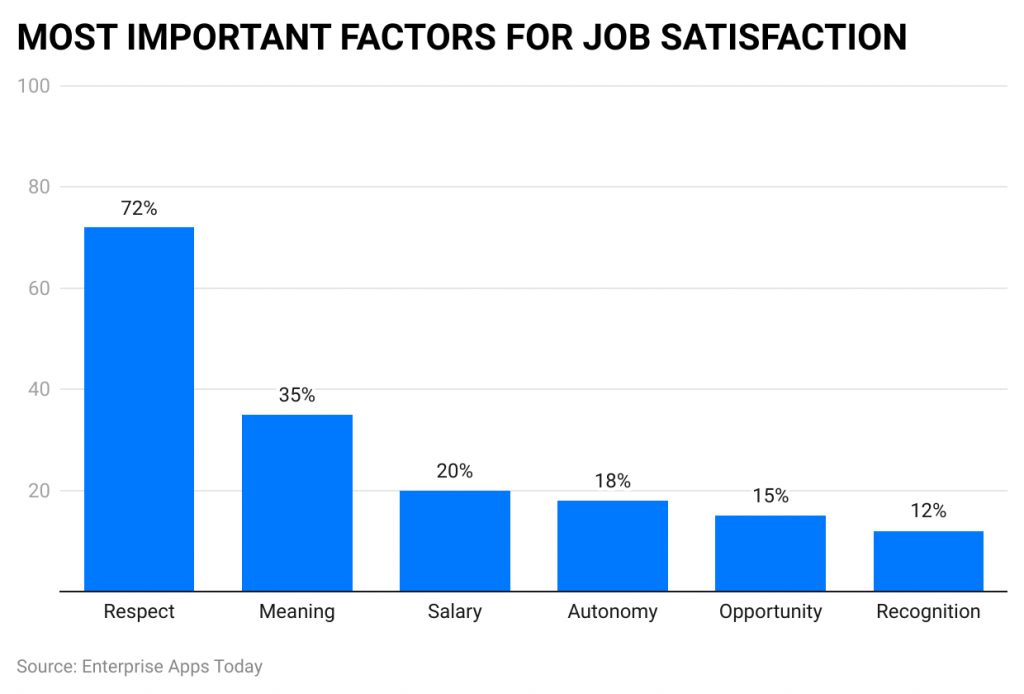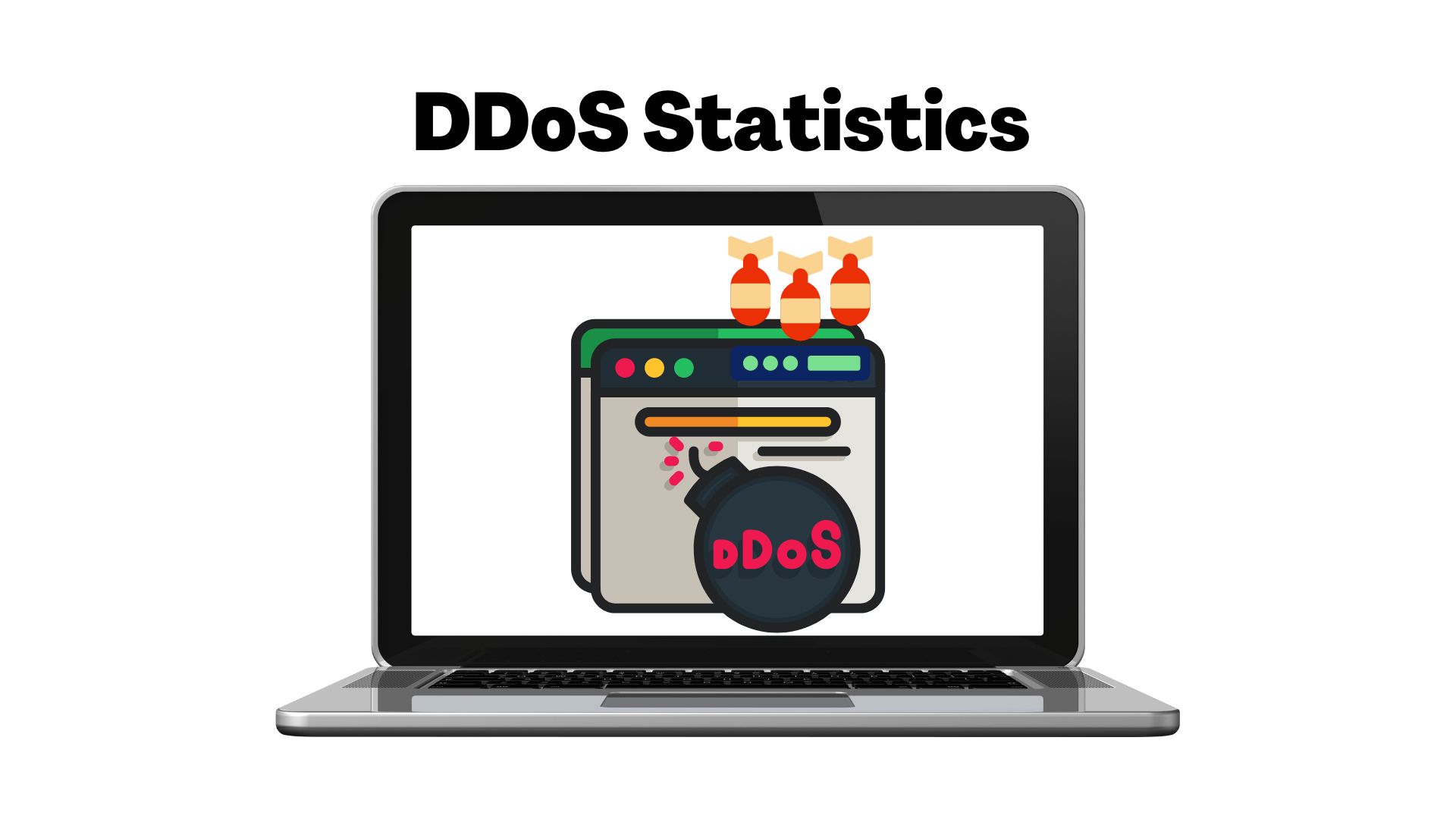24+ Surprising Job Satisfaction Statistics For 2023: Average Job Satisfaction In The United States

Page Contents
Job Satisfaction: What Is It?
Job Satisfaction Statistics: The term job “job contentment,” also known as “employee satisfaction,” is used in companies to understand the state of workers' unhappiness or happiness in their jobs.
Organizations that want to have the best results can use job satisfaction statistics. They strongly correlate with staff output, retention, and overall happiness in the workplace. In addition, employers who wish to succeed with the best talent at their side need to comprehend the entire scope and importance of employee satisfaction stats. In this article, we will discuss the most important job satisfaction statistics.
Job Satisfaction Statistics for 2023 (Editor's Choice)
- 77% of employees believe their coworkers remained very satisfied with overall job satisfaction.
- 55% of US workers are expected to search for new jobs within the next 12 months.
- 36% of employees globally claimed that they are in love with their current job.
- 75% of workers quit their jobs due to managerial conflicts.
- Remote work is preferred by 32% of respondents across the world.
- In the United States, 60% of workers are happy with their jobs in 2023.
- By the end of 2023, around 61% of American employees will leave their current jobs.
Job Satisfaction
 (Source: myperfectresume.com)
(Source: myperfectresume.com)
#1. The majority of workers, around 89.05%, anticipate at least three benefits from their employer.
According to job satisfaction statistics, employer benefits are a significant indicator of workplace pleasure for many, with most respondents in a Good Firms poll expecting at least three workplace benefits. The most popular benefits include working five days per week (75.33%), flexible hours (74.54%), and annual raises (81.10%).
(Source: GoodFirms)
#2. 60% of workers believe coworkers are the most important contributor to job happiness.
According to job happiness stats from 2019, up to two-thirds of employees believe their coworkers are the most significant contributor to workplace happiness. By comparison, high-predicted happiness factors such as the possibility of future advancement inside a company were prioritized by only 39.3% of respondents. The importance of commute was as high as that of colleagues, followed by the work environment, the supervisor, and interest in the work itself.
(Source: Statista)
#3. For 90% of workers, a respectful workplace is necessary for job satisfaction.
According to a survey by the Society of Human Resource Management, respect in the workplace is becoming more important among workers, with nearly 72% of respondents saying it's the most crucial indicator of job satisfaction.
In the United States, 9% of employees are currently happy with their current jobs.
27% of workers believed that they weren’t paid enough which enhanced job dissatisfaction rate in 2023.
In the last 3 months, around 30% of U.S. workers have already quit their jobs.
(Source: SHRM)
#4. 56.68% of employees worldwide are satisfied with their jobs.
GoodFirms research shows that more than half the employees are satisfied with their current jobs, while 30.15% are unhappy. In addition, around 13.17% of respondents were unsure or neutral about their current position.
(Source: GoodFirms)
#5. 70.87% of workers consider fair treatment at work to be essential.
A positive workplace culture can help to increase job satisfaction, with fair treatment at work being especially important to 70.87% of employees. This includes having work that is in line with their interests (71.40%), achieving a healthy life/work balance (70.60%), as well as having a friendly boss (69.53%).
Interestingly, growth opportunities were the highest priority in this survey (73.62%), while it is relatively low on the list of factors according to Statista research.
(Source: GoodFirms)
Dissatisfaction In The Workplace
Although job satisfaction statistics indicate what employees want in modern workplaces, rising job turnover rates show the need to address workplace dissatisfaction. Here are some of the most crucial aspects, so employers are aware of what individuals typically find problematic:
#6. Only 34% of US workers report feeling engaged in the workplace.
Gallup's survey recently found that only 34% of employees in the United States feel engaged at work.
The US's job satisfaction stats are slightly higher than the global average and better than Canada's (just 19%). However, that still leaves most US employees feeling like their jobs are not fulfilling enough.
(Source: Gallup)
#7. 79% of those who leave their jobs do so because they feel undervalued.
79% of individuals who quit their jobs feel undervalued as a primary reason for doing so. In comparison, a manager's failure to recognize hard work even once per 12 months was highlighted by as many as 65% of employees in North America.
(Source: O.C. Tanner)
#8. 75% of workers quit their jobs because of managerial disputes.
Comparatively, studies show that up to 75% of workers who quit their jobs do so because they are unhappy with management, mainly because a lack of respect is now prioritized by up to 72% of workers. Workers who have a good relationship and feel supported by their managers are more likely to be productive and stay in their jobs.
(Source: Gallup)
#9. Just 12% of workers quit their jobs in search of more money.
89% of workers believe that employees will quit a job to make more money. However, research shows that only 12% of respondents will be willing to leave a job based on their pay grade.
(Source: HR Daily Advisor)
#10. 73% of employees are willing to stay with a company that offers skill-building opportunities.
According to a recent LinkedIn study, 73% of workers said they would be happier to stay in their jobs if there were more opportunities for skill development. This finding shows that a lack of job advancement is still a significant source of employee dissatisfaction.
(Source: LinkedIn)
Work Satisfaction By Age
Latest statistics on job satisfaction have shown that there is often a stark difference in the happiness and priorities of workers across various age groups. The upcoming Gen Z and Millennial workforce are particularly putting a lot of pressure on employees to ensure equality and workplace wellness. Employers would be wise to focus more on happiness at work among the various age groups in their teams.
25 years and fewer employees by 83% and 26 years to 40 years 70% of people remained happy with their jobs in 2023.
#11. Job meaningfulness is least frequently mentioned as a significant factor in job satisfaction by workers between the ages of 18 and 29 years.
Even though 31% of respondents in a most recent CNBC/Survey Monkey survey said that having a meaningful job was important for job satisfaction, younger workers, who are supposedly more socially conscious, were the least likely to follow this trend, placing a lot more importance on factors like pay rates and advancement opportunities.
(Source: CNBC/Survey Monkey)
#12. Millennials are three times more likely to quit their employment.
The largest generation of US workers is now the millennials. And they are at least three times more likely than other generations to leave their jobs, with as many as 21% doing so in the last year. While 43% of millennials expect to move professions in the next two years, only 28% of millennials say they plan to stay in their current positions for longer than five years; this is often due to more opportunities and highly competitive pay elsewhere.
(Source: Gallup)
#13. Around 31% of employees aged 18 to 29 say they are completely satisfied with their jobs.
The number rises with age; the number increases with age—40% of people aged 35 or older report complete satisfaction with their current job. The percentage of full-time employees who are entirely happier with their occupations is 34%, compared to just 23% of part-time employees.
(Source: Pew Research)
#14. 51% of workers between the ages of 18 and 24 prefer a better wage over job security.
According to Pew Research's workplace wellness statistics, although older workers, 59% value job stability more than wage, younger workers (between the ages of 18 and 24) prioritize higher pay over job security.
(Source: Pew Research)
#15. 56% of businesses have recently revised their policies to appeal to a multigenerational workforce.
The baby boomers are retiring later compared to their parent's generation. This is combined with the Gen-X and large Millenial workforces and Gen-Z workers, who are expected to account for 30% of the United States workforce by 2030. This means more businesses with age-diverse teams are on the market than ever before.
(Source: LinkedIn)
Satisfaction By Career
According to job satisfaction stats by profession, job satisfaction can vary substantially depending on a person's industry and career. It's interesting to note that the highest-paying employment doesn't always come from the most lucrative industries. Let's look at this:
#16. One-third of people whose annual salaries are less than $25,000 have job satisfaction rates that are less than 50%.
Outside of people industries, Payscale's research (which compared up to 454 positions across the workforce) found that, while not a very good indicator of job satisfaction, low incomes are unsurprisingly associated with lower job satisfaction rates.
(Source: Payscale)
#17. Public sector workers report greater levels of satisfaction and meaning in their jobs.
Public sector employees frequently report higher levels of job satisfaction despite relatively low pay grades, frequently due to their jobs appearing more significant to them. According to employment satisfaction stats, teachers and healthcare employees rank job meaningfulness level up to 96%, and significantly higher-earning people like chief executives earn 74%.
(Source: Payscale)
#18. At 90%, people in the clergy have the highest job satisfaction rate in the sector.
PayScale's career satisfaction statistics show that, despite having a relatively modest median salary of $46,600, clergy members had the most excellent rates of job satisfaction (90%) and the most vital sense that their job is meaningful (98%).
(Source: Payscale)
#19. Only 5% of parking lot employees think their job is meaningful.
Only 5% of parking lot attendants believe their jobs are significant, making them feel like they have minor meaningful careers in the industry. Other low-ranking jobs include gaming supervisors 20% and fabric & apparel pattern makers, around 25%. Unsurprisingly, these occupations also frequently receive low ratings for job satisfaction.
(Source: Finances Online)
#20. Only 39% of cafeteria workers and dry-cleaners employees experience high job satisfaction.
According to unhappy employees stats from the same PayScale survey, dry-cleaning workers and cafeteria attendants usually have the lowest levels of job happiness, with high job satisfaction rates of just 39%.
(Source: Payscale)
Job Satisfaction by Company

(Source: zippia.com)
#21. In 2023, job satisfaction by 42% impacted by organizational culture.
In the United States, private sector companies' organizational culture has impacted 42% of job satisfaction.
Other sectors' job satisfaction share is followed by the Nonprofit sectors (65%), the Government sector (67%), and the Self-employed sector (62%).
Whereas in 2023, the employment engagement rates in the U.S. resulted in 30% to 40%
The Impact of Job Dissatisfaction
The fact that job unhappiness is still growing across many parts of the globe shows that workers do not care enough or fail to understand about seriousness of job dissatisfaction. In light of this, a study of job satisfaction would not be complete without considering the following findings of persistent unhappiness among any workforce:
#22. 55% of US workers are expected to search for new jobs within 12 months.
Bankrate’s August 2023 survey found that more than half of employees in the United States planned to search for new jobs within the next 12 months. Up to 45% of respondents who weren’t actively looking for a new job at the time of the survey anticipated doing so at some point in the next 12 months.
(Source: Bankrate)
#23. 52% of workers in the United States are undermotivated and uninspired.
According to statistics on job satisfaction, 52% of employees in the United States feel dissatisfied with their jobs. The worst part is that a sizable majority of these workers (67%) think things have worsened since the COVID-19 epidemic.
(Source: Indeed)
#24. Only half of the workers outside the management trust their firms.
According to a poll done by Edelman Trust Barometer, roughly 48% of non-managerial employees trust their company, compared to 64% of executive staff. This disconnect complicates daily work and overall company growth because mistrust leads to lower employee engagement, less happiness at the workplace, and ultimately, reduced productivity.
(Source: Harvard Business Review)
#25. Low employee engagement costs US businesses $450 billion to $ 550 billion annually.
Job satisfaction stats frequently exclude the reality that the problem of disgruntled employees also has significant financial implications. Businesses that ignore employee satisfaction cost the United States as much as $450–550 billion annually, leading to an increase in turnover, lower employee productivity, employment drives, and a general lack of effort on their part.
(Source: Gallup)
Job satisfaction and productivity
As of 2023, in the United States, the annual loss of unhappy employees is at least $550 billion which results in 15% profitability loss and 18% lower productivity.
In the same year, employees remained happy and satisfied by 13% more productive.
Important Factors of Job Satisfaction
 (Source: zippia.com)
(Source: zippia.com)
Some important factors of job satisfaction in 2023 are Respect (72%), meaningfulness (35%), salary (20%), autonomy (18%), opportunity (15%), and recognition (12%).
In the U.S. 20% of workers are passionate about their jobs.
As a result of outsourcing and automation around 37% of Americans fear being laid off.
Employees who are annually earning above $75,000 are claimed to gain a higher job satisfaction rate than those earning $30,000 and less.
Conclusion
This statistics research on job satisfaction makes it clear that businesses perform very well when employees are happy with their jobs. Employees who are engaged love what they do, perform better, have a healthy work-life balance, and feel appreciated. These employees' good attitudes influence the business's performance, leading to increased output and more income. Companies need to show appreciation for their employees, as they are the most valuable resource in your company.
Sources
FAQ.
Members of the clergy have the highest level of satisfaction among all employees, at 90%. Job satisfaction is also high among healthcare professionals and teachers.
According to a GoodFirms survey, more than half of people worldwide are satisfied with their jobs - 56.68%, to be exact. Regarding job satisfaction statistics, an alarming number of individuals in the United States are unmotivated and burnt out (52%), while just 34% of people feel engaged in their workplace.

Barry is a lover of everything technology. Figuring out how the software works and creating content to shed more light on the value it offers users is his favorite pastime. When not evaluating apps or programs, he's busy trying out new healthy recipes, doing yoga, meditating, or taking nature walks with his little one.



